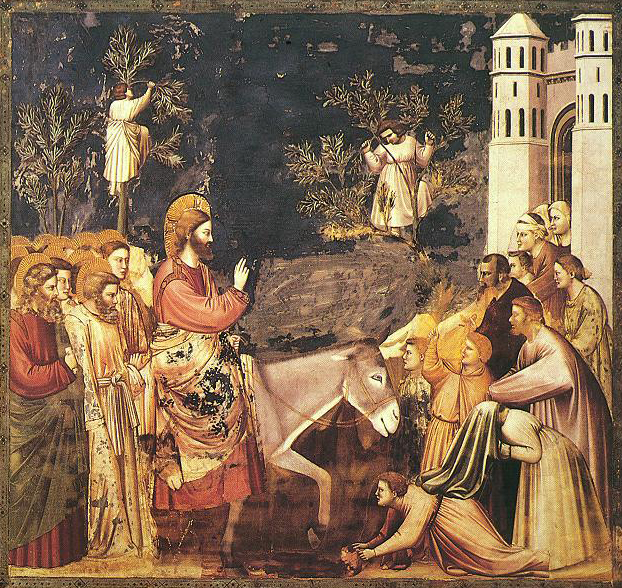All Glory, Laud, and Honor

Over the course of the liturgical year, the Church celebrates the decades of her Lord’s life from his conception through his ascension, often skipping through years of the story from week to week. But during Holy Week, time slows down. This week, the climax of the Church year—also known as the “Great Week,” “Sacred and Great Week,” or even the “Laborious Week” due to its even more intense fasting and prayer practices—is a time for the Church to walk with her Lord in time as he approaches his crucifixion.
Palm Sunday, or Palmarum, is our entrance into Holy Week. The account of our Lord’s triumphal entry is recorded in all four Gospels. By this time in Jesus’ ministry, he is surrounded by crowds who have seen his miracles, even the raising of a dead man, and believe in him! (John 11). As he approaches Jerusalem, Jesus sends two disciples ahead to acquire a donkey, a young colt, thus fulfilling the prophet Zechariah’s words:
“Behold, your king is coming to you,
humble, and mounted on a donkey,
on a colt, the foal of a beast of burden.”
Matthew 21:5”
The crowds present for the feast of Passover throw their cloaks and palm branches on the ground before him while crying out, “Hosanna! Blessed is he who comes in the name of the Lord!” (Matt. 21:9).
We see that the tension between Jesus and the Pharisees is also at a climax at the end of this account when the Pharisees order Jesus’ to rebuke his disciples, but he responds that if he were to do so, the very stones would cry out!
Brief History
From the third and fourth centuries, it became a popular practice for Christians to follow along the physical path of Jesus’ last days on earth. In that spirit, they would observe Palm Sunday by traveling the very road into Jerusalem that our Lord traveled on that day. Since not all Christians could take part in this practice, churches began holding their own processions, which began outside the church and made their way through town and finally into the nave.
Through the centuries, Jesus presence in these processions has been expressed through a myriad of symbols. Some have processed in with the Gospel book, while in some parts of Germany, a Palmesel (palm donkey) with a Jesus figure riding on the wooden donkey’s back makes its way into the church.

While Christians’ religious practices for Palm Sunday varied, it was customary for the entire society to observe Holy Week by putting aside their worldly cares such as entertainment and dancing as well as their business—from kings and rulers to the farmers who set would not touch a plow until after the Easter celebrations. It was a sacred and quiet time.
Today Lutheran churches generally continue to observe this Sunday in the Church year by participating in this palm processional. The choir, for example, might sing the entrance hymn while the congregation waves branches, or in some areas the procession still begins outside the church and make its way in, symbolizing Jesus’ entrance into Jerusalem. A common hymn for the processional is LSB 442, “All Glory, Laud, and Honor,” which has been used on Palm Sunday since the eighth century! In this hymn, we join our voices with the pilgrims of Jesus’ day and the heavenly choirs who sing his praise leading up to his Passion. With them we join in the refrain:
“All glory, laud, and honor to You, Redeemer, King,
To whom the lips of children made sweet hosanas ring.”
Collect
Almighty and Everlasting God, who hast sent Thy Son, our Savior Jesus Christ, to take upon Him our flesh and to suffer death upon the cross that all mankind should follow the example of His great humility: mercifully grant that we may both follow the example of His patience, and also be made partakers of His resurrection; through the same, Jesus Christ, Thy Son, our Lord, who liveth and reigneth with Thee and the Holy Ghost: ever one God, world without end. Amen.
Lessons
Resources
Issues, Etc. interview with the Rev. David Petersen on Palm/Passion Sunday
Propers found in Daily Divine Service Book: A Lutheran Daily Missal, edited by the Rev. Heath Curtis
References:
1. Weiser, Francis X. Handbook of Christian Feasts and Customs: The Year of the Lord in Liturgy and Folklore. Harcourt, Brace & World, Inc. 1952.
2. Pfatteicher, Philip H. Journey into the Heart of God. Oxford University Press. 2013.
3. Vitz, Evelyn Birge. A Continual Feast. Ignatius Press. 1985.
Images:
1. Christ’s Entry into Jerusalem, from The Small Passion, Albrecht Dürer, Germany, ca. 1508.
2. Entry into Jerusalem, Giotto di Bondone, Italy, 14th century.
Some links might be affiliate links which means we may receive a small commission at no extra cost to you. As an Amazon Associate we earn from qualifying purchases.




Your description is so vivid of these events, I feel as if I am on the streets with my Jesus!